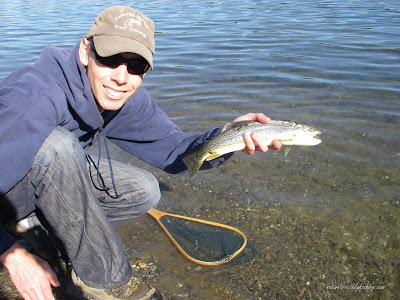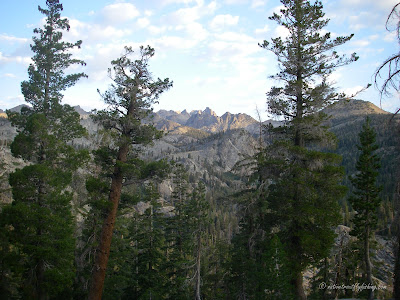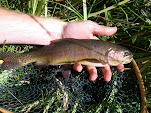Day 9: Wednesday September 9th 2009: The weather was clear once again when we left Santa Fe, headed for a small creek in the headwaters of the Pecos River drainage. It took us a little over an hour to reach the trailhead that would provide us with access to a small stream that was said to hold a population of large spotted Rio Grande Cutthroat.
 |
| The view of the valley from the trailhead |
After rigging up, we made our way down to the creek which was smaller and brushier than what I had expected. We decided to head upstream hoping that maybe the vegetation would thin out a bit or that we could find some decent pockets to fish. Within the first five minutes I found a little pocket along an undercut bank and watched a nice looking fish grab my dropper. The fish didn't have anywhere to go, but as I went to net him my size 18 Copper John came loose and it darted off downstream. For the next half mile I only spotted a handful of fish, all of which were either holding in impossible to fish spots or spooked before I could get close enough to cast to them. Derek faired no better, but I was dead set on catching one of these fish so we continued to work our way upstream. The further upstream we got the more fish we saw, and I did manage to rise a few but couldn't get any solid hookups.
 |
| A brushy run on the creek |
I finally came to a pool that had an open angle to cast from, some good cover to allow for a stealthy approach and most importantly two good-sized Cutthroat holding in the tail out. I didn't want to take any chances here so I sized up my cast and tried to aim for the larger of the two fish. My first cast was a little short but my next cast was right on target, upstream and slightly to the right of the larger fish. The larger Cutthroat slowly cruised over to my fly, took a quick look and changed its mind. I was thinking that the fish had found something wrong with my fly, but before I decided to pick up my fly up to make another cast the fish turned back around, swam over to my fly and nipped at it before changing its mind again. However, just as quickly as this fish decided to refuse my offering it changed its mind for a third time and finally confidently slurped my dry fly. I allowed a second of pause before setting the hook and was tied into the fish. This time my hook up was solid and after a short battle I was able to bring the beautiful Rio Grande Cutthroat to my net.
 |
| A large spotted Pecos strain Rio Grande Cutthroat |
While photographing this Cutthroat, I noticed that the clear blue sky that we had started out with was now blanketed with scattered clouds, but I really didn't pay too much attention to it at the moment. Instead, I continued upstream and found a nice deep pool where I caught another slightly smaller Rio Grande Cutthroat and hooked a couple of others, before the now all too familiar sound of thunder told us that it was time to head back to the car.
 |
| Another Rio Grande Cutthroat |
 |
| A pool on the Pecos River tributary |
 |
| Stormy weather once again |
It was impressive to watch how fast this storm built up, as by the time that we got back to the car and put the gear away it was right on top of us. When we hit the road, it was just beginning to pour, but a few minutes down the road we were able to leave bad weather behind us. The rest of the day was spent in the car getting to Denver, Colorado where I would be picking Blake up to head to Fly Fishing Retailers Show.
Day 10: Thursday September 10th 2009: I picked Blake up at the airport in Denver at 9:30AM for a full day at the FF Retailers Show. Our goal for the show was to look for some new products that would fit in well with the line up of gear at the Gig Harbor Fly Shop. We were most impressed with Scott the S4S, a faster action saltwater version of the Scott S4, which would go on to win the 2009 FF Retailers Choice Award. The rod that personally caught my eye though was the Scott F series 6' 1wt rod. With my day on the brushy little Rio Grande Cutthroat stream in New Mexico still fresh in my mind, this short but durable little fiberglass rod was looking VERY appealing, and is likely to find its way into my rod line up in the near future.
After the show, Blake and I walked back to our hotel a couple miles away and Derek and I discussed our plans for the rest of the trip. Since Blake and I hadn't finished looking at everything, we decided that I would join him at the show till around 10:00 AM and then Derek and I would hit the road, since we had over 20 hours of driving ahead of us. Derek and I had decided to make a side trip through Yellowstone on the way back, since he had never been there which would make for a longer drive but gave us something to look forward to.
Day 11: Friday September 11th 2009: After a quick morning at the Fly Fishing Retailers Show, it was time for Derek and I to hit the road again for our long drive. Our drive getting out of Denver was a slow due to a nasty car wreck, but once we got past that we started making good timing. The drive really wasn't all that eventful until we got within a couple of hours of Jackson Wyoming, where the combination of the Wind River Range on the horizon and Pronghorn Antelope on their annual migration through the Green River valley made things a bit more interesting. While we didn't see nearly as many antelope as I had seen last October, but the front edge of the migration had definitely reached the valley and we spotted close to a hundred antelope before we crossed the pass into the Hoback River drainage. We pulled into Jackson, WY at around 7:00 PM wandered around town for a bit before heading up the Gros Ventre valley to camp for the night.
Day 12: Saturday September 12th 2009: This was our day to see the sights of Yellowstone and the Tetons before cutting the distance between us and home down by as much as possible. The only catch to our time in Yellowstone was that with our remaining drive there wouldn't be anytime to fish. Something that I always struggle with when surrounded by so many amazing trout streams. Our first stop of the trip was Grand Teton National Park, which we more or less just cruised through on our way north, although we did have to stop for a couple of photos.
 |
| The Tetons |
After getting out of the Tetons, we headed up to Old Faithful so that Derek could see the most famous feature in Yellowstone. When we pulled into the parking lot, the board walk around the geyser, it was already filled with people, which usually means that the geyser is about to go off. I didn't want Derek to miss the eruption and have to wait another hour, so I dropped him off before going to search for parking myself. By the time the I parked the car and got within a hundred feet of Old Faithful, it finally went off. This is the second year in a row that I have had such good timing. After getting to experience Old Faithful, Derek and I did a quick hike around the Geyser basin then headed over to the lodge to grab an early lunch.
 |
| The Firehole River in the Geyser basin |
From Old Faithful, we headed over to the Yellowstone River valley with hopes of getting to see some more of the park's abundant wildlife. Between Old Faithful and the Grand Canyon of the Yellowstone we only saw around ten bison and one deer, certainly less wildlife than I have come to expect. We did make up for this a little bit by getting out of the car to do some hiking and sight seeing.
 |
| One of the park's many thermal features |
 |
| Yellowstone Falls and the Grand Canyon of the Yellowstone |
Even after covering the drive between Yellowstone Falls and Tower Junction we hadn't seen anymore wildlife, so I decided to make a quick side trip up the Lamar Valley to Soda Butte Creek. This was a good call, as we saw numerous herds of Bison and Pronghorn Antelope up and down the valley. Although it was tough for me to pass through this near perfect valley without sampling its waters, Soda Butte Creek and the upper Lamar were both crawling with way too many anglers, which eased my pain a bit. I amazes me the increase in pressure that these streams have seen just since I have been visiting the park. Another reason that I favor the small out of the way waters that the average angler will never see.
 |
| A Lamar Valley Bison |
After heading back down the Lamar Valley, we made one more quick stop at Mammoth Hot Springs where the typical several dozen Elk were lounging in the grass, before we finally headed out of the park. While I had intended on driving to the Missoula area at the furthest, but I really didn't feel all that tired when we drove through town at around 9:00 PM so we decided to keep going. After having gone this far, we decided that we might as well try to get back to Derek's place in Yakima, WA and by the time that we finally pulled into the driveway at 2:00 AM I was tired enough to be happy to be out of the car.
Day 13: Sunday September 13th 2009: I got up early in the morning, or at least as early as I could manage with the combination of 18 hours in the car and transitioning back to Pacific Time and finished the drive home in a mere two and a half hours that flew by. Even though this was my longest native trout adventure to date, it flew by so fast that I hardly noticed it. I have to say that I really couldn't have asked for more out of this trip as all of the pieces seemed to just fall into place perfectly and I managed to accomplish exactly what I set out to do. However, after driving nearly 4500 miles I was definitely glad to be back home.


































































